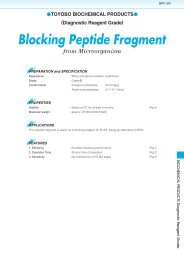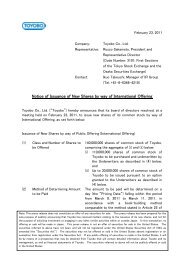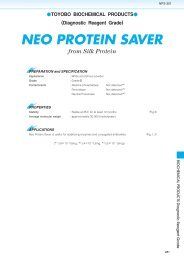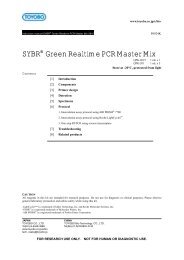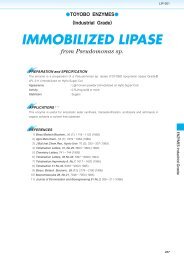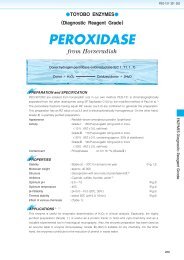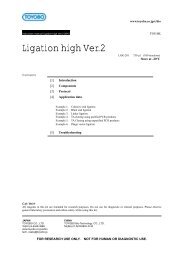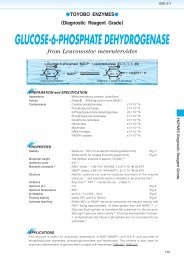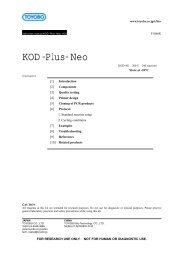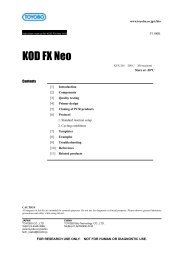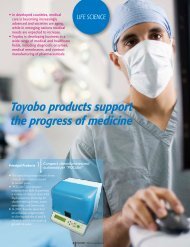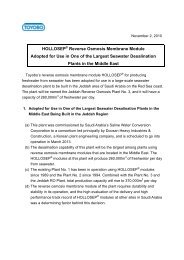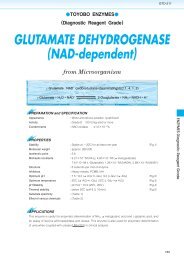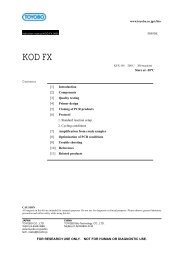BREATHLEATHER - Toyobo
BREATHLEATHER - Toyobo
BREATHLEATHER - Toyobo
Create successful ePaper yourself
Turn your PDF publications into a flip-book with our unique Google optimized e-Paper software.
November 8, 2012<br />
<strong>Toyobo</strong> Co., Ltd.<br />
<strong>Toyobo</strong> Announces the Development of<br />
“<strong>BREATHLEATHER</strong> ® ”<br />
An Artificial Leather for Automotive Seats Based<br />
on <strong>Toyobo</strong>’s Tactile Sense Measuring Technology<br />
<strong>Toyobo</strong> has successfully created a tactile sense measuring technology for<br />
quantifying comfortability. Recently, using this technology, <strong>Toyobo</strong> has also<br />
developed <strong>BREATHLEATHER</strong> ® , which is an artificial leather for automotive<br />
seats that does not feel “sticky.”<br />
1. Background for the Development of <strong>BREATHLEATHER</strong> ®<br />
<strong>Toyobo</strong> has been developing human sensation measuring technology to<br />
quantify skin sensations since the latter half of the 1970s based on devices to<br />
quantify skin sensations. To apply this technology to automotive uses, <strong>Toyobo</strong><br />
conducted surveys of consumers to determine the tactile sensations required<br />
for automotive seats. As a consequence of these activities, <strong>Toyobo</strong> has<br />
determined that consumers prefer that the outer layers of automotive seat<br />
materials have the following sets of characteristics: (a) not sticky, soft, and dry<br />
or (b) not sticky and soft as well as are soft and smooth.<br />
Creating a tactile sense measuring technology that makes use of a skin model<br />
(a device developed by <strong>Toyobo</strong>) and KES*, <strong>Toyobo</strong> has developed both<br />
artificial leathers that have the properties of “not sticky, soft, and dry” and<br />
those that are “not sticky and soft as well as are soft and smooth.” The new<br />
artificial leather <strong>BREATHLEATHER</strong> ® was developed by combining <strong>Toyobo</strong>’s<br />
technologies for specialty organic polymers and tactile sense measuring with<br />
the coating technology of <strong>Toyobo</strong> Group company Toyo Cloth Co., Ltd.<br />
*KES stands for the Kawabata Evaluation System, which is used to quantify the texture of cloth, and is<br />
available on the market to measure five physical properties of cloth: namely, surface, bending, compression,<br />
shear, and stretching.<br />
2. Features of <strong>BREATHLEATHER</strong> ®<br />
(a) <strong>BREATHLEATHER</strong> ® provides leathers that are not sticky and have a dry<br />
feeling as well as those that are not sticky as well as are soft and smooth to
the touch through the formation of special<br />
outer layer skin surfaces that contain<br />
specialty organic polymer powders with<br />
superior moisture absorption and desorption<br />
properties as well as through regulation of the<br />
unevenness of the surface.<br />
(b) <strong>BREATHLEATHER</strong> ® makes it possible to<br />
reduce the weight of the leather used in<br />
automotive seats by one-half in comparison<br />
<strong>BREATHLEATHER</strong> ®<br />
with other artificial leather (polyvinyl chloride (PVC)) and by one-third<br />
compared with natural leather.<br />
(c) <strong>BREATHLEATHER</strong> ® also meets the requirements for durability and other<br />
physical properties required for automotive seats.<br />
Structural Properties of Differing Seat Materials<br />
Specialty organic polymer powders, with superior moisture absorption and<br />
desorption properties, contained in the special outer surface of the materials,<br />
give <strong>BREATHLEATHER</strong> ® a dry, more-satisfying feeling.<br />
<strong>BREATHLEATHER</strong> ® PVC Natural Leather<br />
3. Explanation of <strong>Toyobo</strong>’s Tactile Sense Measuring Technology<br />
As a result of the preparation of a sense map using <strong>Toyobo</strong>’s tactile sense<br />
measuring technology, compared with other artificial leather used in<br />
automotive seats, such as PVC, which is in general use for this application,<br />
<strong>BREATHLEATHER</strong> ® does not have a feeling of stickiness because of the low<br />
rise in palm humidity due to the application of a skin model. In addition, the<br />
three types of artificial leather in <strong>Toyobo</strong>’s new <strong>BREATHLEATHER</strong> ® lineup<br />
have the following properties. <strong>BREATHLEATHER</strong> ® –DS, the dry type, has a
dry feeling because of its lower friction coefficient. On the other hand,<br />
<strong>BREATHLEATHER</strong> ® –WL and <strong>BREATHLEATHER</strong> ® –DL, the two soft and<br />
smooth types, give a sensation of softness and smoothness because of their<br />
higher friction coefficient. <strong>BREATHLEATHER</strong> ® –WL in particular, which has<br />
specifications that make it suitable for luxury car seats, offers a large<br />
compression displacement with a low load as well as a small surface asperity,<br />
thereby providing a feeling of softness and smoothness.<br />
Tactile Sense Map<br />
Tactile Sense Map<br />
4. Outlook<br />
<strong>BREATHLEATHER</strong> ® has already been adopted by non-Japanese automotive<br />
manufacturers, and <strong>Toyobo</strong> aims to expand its usage in automotive<br />
applications more widely.<br />
In addition, <strong>Toyobo</strong> will not restrict the use of <strong>BREATHLEATHER</strong> ® to<br />
automotive applications but expand it to all types of uses, with the aim of<br />
attaining annual sales of ¥1 billion.<br />
Supplementary Information<br />
1. Sensation Measuring Technology<br />
With the goal of “adopting a scientific approach to<br />
measuring comfort,” since the latter half of the 1970s,<br />
<strong>Toyobo</strong> has been developing its human sensation<br />
measuring technology and applying it to develop<br />
various devices to quantify skin sensations. As part of<br />
these activities, <strong>Toyobo</strong> developed its original<br />
“perspiring mannequins” named TOM ® III and SAM ® .<br />
In addition, <strong>Toyobo</strong> has been working on the<br />
Perspiring<br />
TOM ® III<br />
mannequin
development of technologies for psychological and physiological measurement<br />
to assess psychological states using physiological measures and on simulation<br />
technology to predict the pressure exerted by clothing on wearers using<br />
numerical computation technology.<br />
2. Tactile Sense Measuring Technology<br />
Recently, making use of a skin model (a device developed by <strong>Toyobo</strong>) and<br />
KES (please see reference on page 1), <strong>Toyobo</strong> has devised a technology for<br />
tactile sense measurement.<br />
The skin model is the same perspiration-emitting, hot plate model device used<br />
in <strong>Toyobo</strong>’s perspiring mannequin SAM ® . This device was used to show that<br />
when the degree of increase in palm humidity, represented by H (the degree of<br />
increase in the humidity in the space between the hot plate and the test<br />
material), is low and the friction coefficient, as measured by the KES, is also<br />
low, then this indicates a “not sticky, dry sensation.” The device was also used<br />
to make it clear that when the degree of increase in the palm humidity is low<br />
and the friction coefficient is large, this indicates a “not sticky as well as soft<br />
and smooth sensation.” In addition, this device also enabled <strong>Toyobo</strong> to<br />
understand that a soft and smooth sensation requires a large compression<br />
displacement with a low load as well as a small surface asperity.<br />
In addition, it is possible to assess softness through measures of bending<br />
properties of the material.<br />
Diagram of the Skin Model<br />
Palm Humidity Graph<br />
For more information, contact:<br />
The <strong>Toyobo</strong> Public Relations Group<br />
pr_g@toyobo.jp



